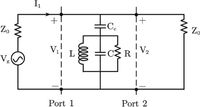Researchers have made significant strides in the field of superconducting quantum information processing (QIP) by demonstrating the feasibility of superconducting quarter-wavelength composite right/left-handed (CRLH) transmission line (TL) devices. These innovative components promise to drive advancements toward more effective quantum computing systems with enhanced control over microwave transport properties.
Superconducting transmission line resonance is fundamental to quantum computation and single-photon detection, but traditional superconducting TLs, which typically operate under linear dispersion relations, face challenges related to mode control and uniform mode spacing. Researchers have explored more sophisticated designs, yielding the CRLH-TLRs, which benefit from their unique electromagnetic properties.
Utilizing computer simulations and experimental setups, the team analyzed the transport characteristics of these CRLH-TLRs. The configuration was constructed by etching high-purity aluminum films onto silicon dioxide (SiO2) substrates, with subsequent microwave transport properties evaluated at low temperatures of around 50 mK. The research findings reveal significant non-uniform spacing between modes, resulting from the nonlinear dispersion relation exhibited by these metamaterials.
By employing both conventional analysis and a novel real-space modeling approach, researchers could accurately depict the behavior of traveling microwaves within the CRLH-TLR, moving beyond previous equivalent circuit models. This enhanced insight allows for potential applications of these devices in QIP environments where precise control of qubit states is imperative.
Notably, the ability to characterize modes without generating crosstalk opens doors for mutual interactions among multiple superconducting qubits, aligning with future needs for increasingly complex quantum computing architectures. The authors state, "The results show clearly the modes can be well controlled without generating crosstalk, which could provide certain novel applications for the QIPs based on the multi-mode driven circuit QEDs and also the sensitive single-photon detections."
The simulation results confirmed the expected physical behavior of the devices, with experimental measurements aligning closely with theoretical predictions. The characterized parameters included the S21 transmission coefficient, with notable dips indicating the distinct frequency modes at well-defined GHz ranges.
The CRLH-TLR design ensures enhanced control with relative ease when compared to traditional devices, which typically encounter limitations related to linear dispersion and uniform mode spacing. The measured intervals between nearest-neighbor modes verified their non-uniform characteristics, typically yielding different separations, with researchers noting the practical alignment of theoretical and empirical data. The authors highlighted this innovation: "This indicates, compared with the usual superconducting quarter-wavelength RH-TLRs with uniform frequency spacing, the demonstrated microstrip superconducting quarter-wavelength CRLH-TLRs could provide certain novel applications for the superconducting QIPs."
Through rigorous design and measurement techniques, these advanced CRLH devices showcase potential improvements for superconducting quantum devices and highlight the key role of nonlinear dispersion properties. The research not only confirms the operational viability of metamaterial transmission lines but also sets the stage for future opportunities toward more complex implementations of quantum information systems.
The culmination of these findings solidifies the potential of superconducting CRLH-TLRs as pivotal components within the quantum computing domain, underscoring the need for continued exploration and innovation within this trifecta of superconductivity, metamaterials, and quantum processing.




